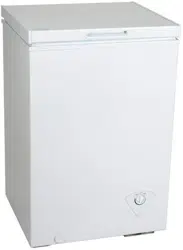Loading ...
Loading ...
Loading ...

67
CARE AND CLEANING (cont.)
POWER FAILURE
Most power failures are corrected within a few hours and should not affect the temperature of your
appliance if you minimize the number of times the door is opened.
NOTE: If the unit is unplugged, has lost power, or is turned off; you must wait 3 to 5 minutes before
restarting the unit. If you attempt to restart before this time delay, damage may occur and or the
appliance may not start.
VACATIONS
• Short vacations: Leave the appliance operating during vacations of less than 3 - 4 weeks.
• Long vacations: If the appliance will not be used for over one month, remove all items and unplug
the power cord. Clean and dry the interior thoroughly. To prevent odor and mold growth, leave the
door open slightly, blocking it open if necessary.
MOVING YOUR FREEZER
1. Remove all contents and store properly.
2. Securely tape down all loose items inside your appliance.
3. Turn the leveling screws up to the base to avoid damage.
4. Tape the door shut.
5. Be sure the freezer stays in the upright position during transportation. Protect the outside with a
blanket or similar item.
HELPFUL HINTS
1. Installer le congélateur dans la partie la plus fraîche de la pièce, loin de la chaleur des appareils ou
conduits de chauffage, et à l'abri de la lumière directe du soleil.
2. Laisser les aliments chauds refroidir à température ambiante avant de les placer dans le congéla-
teur. Les aliments qui mettent longtemps à se congeler peuvent perdre de leur qualité ou se gâter.
3. Une surcharge du congélateur force le compresseur à tourner plus longtemps.
4. Les compartiments du congélateur ne doivent pas être recouverts d'aluminium, de papier ciré ou de
papier absorbant. Ceci pourrait interférer avec la circulation d'air froid, ce qui réduirait l'efficacité du
congélateur.
5. Ranger les aliments de manière à minimiser les ouvertures de la porte et les recherches prolongées.
Sortir autant que possible tous les aliments requis en une fois et refermer la porte aussitôt que
possible.
6. Lors d’une courte panne d’électricité, garder la porte fermée pour que les aliments restent congelés.
Si la panne est plus longue, vérifier l’état des aliments avant de les consommer. Ne pas recongeler
un aliment qui a dégelé.
You can solve many common appliance problems easily, saving you the cost of a possible service call.
Try the suggestions below to see if you can solve the problem before calling the servicer.
PROBLEM POSSIBLE CAUSE
Appliance does not operate. Not plugged in.
The circuit breaker tripped or a blown fuse.
The freezer temperature control is set at "OFF".
Compressor turns on and off The room temperature is hotter than normal.
frequently. A large amount of food has been added to the freezer.
The door is open too often.
The door is not closed completely.
The temperature control is not set correctly.
The door gasket does not seal properly.
The freezer does not have the correct clearances.
The freezer has recently been disconnected for a period of time.
Four hours are required for the freezer to cool down completely.
Temperature inside the freezer Temperature control is set too cold. Turn the control to a warmer
is too cold. setting and allow several hours for the temperature to stabilize.
Popping or cracking sound Metal parts undergo expansion and contraction, as in hot
when compressor comes on. water pipes. This is normal. Sound will level off or disappear
as freezer continues to run.
Bubbling or gurgling sound, Refrigerant (used to cool freezer) is circulating throughout
like water boiling. the system. This is normal.
Vibrations. Check to assure that the freezer is level.
Floor is uneven or weak. Freezer rocks on the floor when it is
moved slightly. Be sure floor can adequately support freezer.
Level the freezer by putting wood or metal shims under part
of the freezer.
The freezer is touching the wall. Re-level the freezer and move
it away from the wall. See “Installation Instructions”.
Moisture forms on inside Weather is hot and humid, which increases internal rate of
freezer walls. frost build-up. This is normal.
Door is slightly open.
Door is kept open too long, or is opened too frequently.
The door is not sealed properly.
Moisture forms on outside Door is slightly open, causing cold air from inside the freezer
of freezer. to meet warm moist air from outside.
The door will not close properly. The appliance is not level.
The gasket is dirty.
The storage basket is out of position.
TROUBLESHOOTING GUIDE
